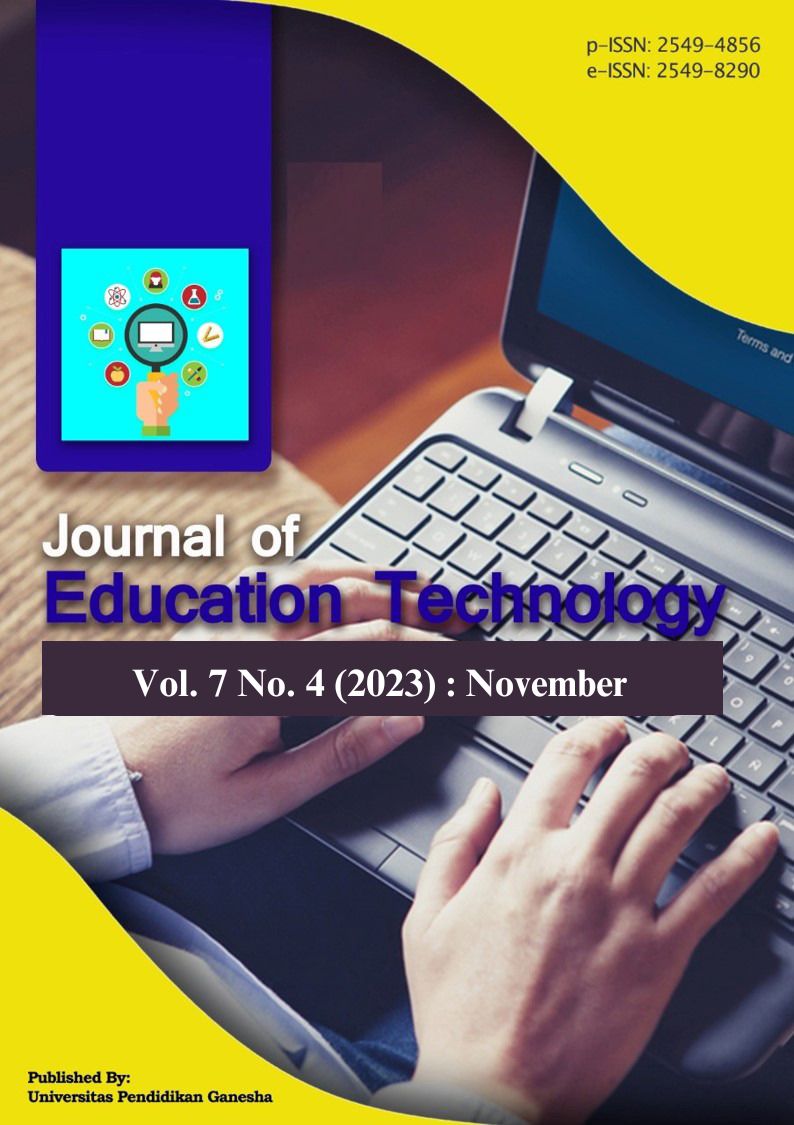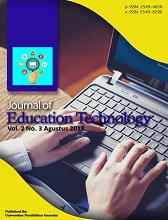Pre-Service Teachers’ Perception of Digital Literacy
DOI:
https://doi.org/10.23887/jet.v7i4.68867Keywords:
Pre-Service Teachers, Perception, Digital LiteracyAbstract
Digital Literacy for teachers, including future teachers is one prominent and influential aspect of living in the 21st century. They need to be digitally literate to be engaged in this digital world and to prepare their students to be digitally literate too. This research aims to assess the level of the pre-service teachers’ digital literacy in one public university in Bali, Indonesia. This study was using a survey study. The participants were involving 158 pre-service teachers. Pre-service teachers are students of teaching training or educational study programs, who are prepared with pedagogical content and skills to prepare them to become teachers. The instrument used in collecting the data was a 5-point-Likert-questionnaire, data triangulation a semi-structured interview with seven pre-service teachers was conducted. The questionnaires were analyzed quantitatively. The study revealed that most of the pre-service teachers reported high levels of literacy in all areas. The results of this study would be beneficial as reflections on the pre-service teachers’ digital literacy as a consideration in the institution’s regular review of the curriculum or training for the pre-service teachers.
References
Aslan, S. (2020). Analysis of Digital Literacy Self-Efficacy Levels of Pre-service Teachers. International Journal of Technology in Education, 4(1), 57. https://doi.org/10.46328/ijte.47.
Avazmatova, M. (2020). Significance Of Blended Learning In Education System. The American Journal of Social Science and Education Innovations, 02(08), 507–511. https://doi.org/10.37547/tajssei/volume02issue08-82.
Blevins, B. (2018). Teaching Digital Literacy Composing Concepts: Focusing on the Layers of Augmented Reality in an Era of Changing Technology. Computers and Composition, 50, 21–38. https://doi.org/10.1016/j.compcom.2018.07.003.
Bolanakis, Di. E. (2019). A Survey of Research in Microcontroller Education. Revista Iberoamericana de Tecnologias Del Aprendizaje, 14(2), 50–57. https://doi.org/10.1109/RITA.2019.2922856.
Carrington, V., & Robinson, M. (2009). Digital literacies: Social learning and classroom practices. In Digital Literacies: Social Learning and Classroom Practices. https://doi.org/10.4135/9781446288238.
Castro, R. (2019). Blended Learning in Higher Education: Trends and Capabilities. Education and Information Technologies, 24(4), 2523–46. https://doi.org/10.1007/s10639-019-09886-3.
Caverly, D. C., Payne, E. M., Castillo, A. M., Sarker, A., Threadgill, E., & West, D. (2019). Identifying Digital Literacies to Build Academic Literacies. Journal of College Reading and Learning, 49(3), 170–205. https://doi.org/10.1080/10790195.2019.1638218.
Chan, B. S. K., Churchill, D., & Chiu, T. K. F. (2017). Digital Literacy Learning In Higher Education Through Digital Storytelling Approach. Journal of International Education Research (JIER), 13(1), 1–16. https://doi.org/10.19030/jier.v13i1.9907.
Eshet-Alkalai, Y. (2004). Digital Literacy: A Conceptual Framework for Survival Skills in the Digital Era. Journal of Educational Multimedia and Hypermedia, 13(1), 93–106. https://www.learntechlib.org/primary/p/4793/.
Evering, L., & Moorman, G. (2012). Rethinking Plagiarism in the Digital Age. Journal of Adolescent & Adult Literacy, 56, 35–44. https://doi.org/http://dx.doi.org/10.1002/JAAL.00100.
Gullifer, J., & Tyson, G. A. (2010). Exploring university students’ perceptions of plagiarism: A focus group study. Studies in Higher Education, 35(4), 463–481. https://doi.org/10.1080/03075070903096508.
Haider, A. (2008). Believable Unbelievable internet based information. ACIS 2008 Proceedings - 19th Australasian Conference on Information Systems, January 2008, 347–356. https://aisel.aisnet.org/acis2008/93/.
Haluk Sivrikaya, M. (2020). An Analysis on Digital Literacy Level of Faculty of Sports Science Students. Asian Journal of Education and Training, 6(2), 117–121. https://doi.org/10.20448/journal.522.2020.62.117.121.
Irawaty, E., Widjaja, E. M., & Sanjaya, J. (2021). Peningkatan Kualitas Belajar Dalam Menghadapi Pembelajaran Daring. Prosiding SENAPENMAS, 985. https://doi.org/10.24912/psenapenmas.v0i0.15131.
Irhandayaningsih, A. (2020). Pengukuran Literasi Digital Pada Peserta Pembelajaran Daring Di Masa Pandemi Covid-19. Anuva, 4(2), 231–240. https://demo.dspacedirect.org/bitstream/handle/10673/1975/8073-25123-1-SM.pdf?sequence=1&isAllowed=y.
Jan, S. (2017). Investigating the relationship between students’ digital literacy and their attitude towards using ICT. International Journal of Educational Technology, 5(2), 26–34. https://eric.ed.gov/?id=EJ1197718.
Lau, W. W. F., & Yuen, A. H. K. (2014). Developing and validating of a perceived ICT literacy scale for junior secondary school students: Pedagogical and educational contributions. Computers and Education, 78, 1–9. https://doi.org/10.1016/j.compedu.2014.04.016.
Leliana, A., Harti, L. M. S., Zuhri, F., & Kusumaningtyas, D. C. S. (2021). Digital Literacy: Text Credibility on Critical Reading Material. Jet Adi Buana, 6(01), 43–51. https://doi.org/10.36456/jet.v6.n01.2021.3512.
Leu, D. J., Zawilinski, L., Forzani, E., & Timbrell, N. (2014). Best Practices in Teaching the New Literacies of Online Research and Comprehension. In Comprehension instruction: research based best practices (pp. 343–362). https://production.wordpress.uconn.edu/newliteracies/wp-content/uploads/sites/448/2014/07/Leu-D.J.-Zawilinski-L.-Forzani-E.-Timbrell-N.-in-press.pdf.
Liza, K., & Andriyanti, E. (2020). Digital literacy scale of English pre-service teachers and their perceived readiness toward the application of digital technologies. Journal of Education and Learning (EduLearn), 14(1). https://doi.org/10.11591/edulearn.v14i1.13925.
Maureen, I. Y., van der Meij, H., & de Jong, T. (2018). Supporting Literacy and Digital Literacy Development in Early Childhood Education Using Storytelling Activities. International Journal of Early Childhood, 50(3), 371–389. https://doi.org/10.1007/s13158-018-0230-z.
Peled, Y. (2021). Pre-service teacher’s self-perception of digital literacy: The case of Israel. Education and Information Technologies, 26(3), 2879–2896. https://doi.org/10.1007/s10639-020-10387-x.
Prachagool, V., Nuangchalerm, P., & Yawongsa, P. (2022). Digital Literacy of Pre-service Teachers in the Period Time of COVID-19 Pandemic. Journal of Educational Issues, 8(2), 347. https://doi.org/10.5296/jei.v8i2.20135.
Prior, D. D., Mazanov, J., Meacheam, D., Heaslip, G., & Hanson, J. (2016). Attitude, digital literacy and self efficacy: Flow-on effects for online learning behavior. Internet and Higher Education, 29, 91–97. https://doi.org/10.1016/j.iheduc.2016.01.001.
Rahman, Ariawan, V. A. N., & Pratiwi, I. M. (2020). Digital Literacy Abilities of Students in Distance Learning. 509(Icollite), 592–598. https://doi.org/10.2991/assehr.k.201215.092.
Rahmi, U., Azrul, A., & Mahande, R. D. (2022). the Prototype of Blended Learning’S Support System To Improve the Pre-Service Teacher’S Digital Literacy. Journal of Educators Online, 19(3). https://doi.org/10.9743/JEO.2022.19.3.5.
Rizal, R., Rusdiana, D., Setiawan, W., & Siahaan, P. (2022). Learning Management System Supported Smartphone (Lms3): Online Learning Application in Physics for School Course To Enhance Digital Literacy of Pre-Service Physics Teachers. Journal of Technology and Science Education, 12(1), 191–203. https://doi.org/10.3926/JOTSE.1049.
Rusdy, M., & Fauzi, F. (2020). Digital Literacy and Cyberbullying Behavior of Youths in Instagram. Komunike, 12(2), 122–145. https://doi.org/10.20414/jurkom.v12i2.2699.
Saputro, S. D., & Setyawan, A. (2020). The Effectiveness Use of Virtual Reality Media in Physics Education of Solar System towards Cognitive Learning Outcomes. JPI (Jurnal Pendidikan Indonesia), 9(3), 390–400. https://doi.org/10.23887/jpi-undiksha.v9i3.23105.
Spires, H. A., Medlock Paul, C., & Kerkhoff, S. N. (2018). Digital Literacy for the 21st Century. In M. Khosrow-Pour (Ed.), Encyclopedia of Information Science and Technology, Fourth Edition (pp. 2235–2242). IGI Global. https://doi.org/10.4018/978-1-5225-7659-4.ch002.
Sutiman, S., Sofyan, H., Arifin, Z., Nurtanto, M., & Mutohhari, F. (2022). Industry and Education Practitioners’ Perceptions Regarding the Implementation of Work-Based Learning through Industrial Internship (WBL-II). International Journal of Information and Education Technology, 12(10), 1090–1097. https://doi.org/10.18178/ijiet.2022.12.10.1725.
Tang, C. M., & Chaw, L. Y. (2016). Digital literacy: A prerequisite for effective learning in a blended learning environment? Electronic Journal of E-Learning, 14(1), 54–65. https://eric.ed.gov/?id=EJ1099109.
Downloads
Published
How to Cite
Issue
Section
License
Copyright (c) 2023 Putu Ayu Prabawati Sudana

This work is licensed under a Creative Commons Attribution-ShareAlike 4.0 International License.
Authors who publish with the Journal of Education Technology agree to the following terms:
- Authors retain copyright and grant the journal the right of first publication with the work simultaneously licensed under a Creative Commons Attribution License (CC BY-SA 4.0) that allows others to share the work with an acknowledgment of the work's authorship and initial publication in this journal.
- Authors are able to enter into separate, additional contractual arrangements for the non-exclusive distribution of the journal's published version of the work (e.g., post it to an institutional repository or publish it in a book), with an acknowledgment of its initial publication in this journal.
- Authors are permitted and encouraged to post their work online (e.g., in institutional repositories or on their website) prior to and during the submission process, as it can lead to productive exchanges, as well as earlier and greater citation of published work. (See The Effect of Open Access)


















